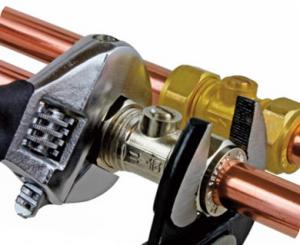Pipes and fittings vary wildly by home, by length, by shape and the number of varying connectors available. Thankfully this isn’t a daunting prospect to an experienced and qualified plumber and there are numerous solutions to make your pipework secure and reduce the risk of leaks!
Plastic vs Copper Piping
At one time, domestic plumbing systems used iron and lead pipes. These days, water is most usually carried around the home in copper pipes, with plastic pipes reserved for waste systems. The modern plastic pipe has its place in the plumbing and heating industry and is being more readily used on heating systems and for the hot and cold water supply thanks to its adaptability and the fact that it can be run through joists with ease. Plastic piping has gained such widespread usage because it can simply be run under floors and fit into all modern pipe clips, as well as being easy to cut (with a specialist pipe cutter).
Plastic Piping In a Nutshell
Pipe comes in straight lengths of three meters and in a variety of different sizes, the most common being 28mm, 22mm, 15mm & 10mm. All plastic pipe manufacturers provide a range of fittings to suit specific requirements, eg: Ts, elbows, couplings, reducers etc. Again, these are all available in a range of different sizes. Plastic pipe comes in two forms; non-barrier (which can be used on hot and cold water supply), and barrier which must be used on heating systems. Most installers use barrier for everything.
Plastic pipe is marked by the manufacturer to show where it fits together. This is an advantage, facilitating installation. PT Plumbing and Heating Ltd engineers also mark pipes themselves for belt and braces!
Some top tips to remember when using plastic piping:
• When joining plastic pipe, it's crucial to remember the plastic protective insert
• It is recommended not to mix brands of plastic push fit systems and always stick to one brand
• Each manufacturer tests their pipe up to a certain pressure and provides a guarantee in line with that
• Plastic pipe tends to be cheaper than copper pipe, however the fittings can be costly
• Savings can be made on installation time when using plastic pipe, making installation quicker
• It is possible to take some plastic systems apart and reuse them which is another advantage.
One disadvantage of plastic pipe is that it has made plumbing more accessible to the DIY market which can sometimes lead to problems! It is easy to install plastic pipework, but well-intentioned DIY-ers do not always understand plumbing and heating systems in full so problems can and do arise.
PT Plumbing and Heating Ltd fully support the use of plastic pipework when the situation demands, for example in non-exposed areas, under the floor and behind kitchen units. We always use copper pipe in areas of install that are visible eg: connections to radiators, sinks, toilets and baths.
For more hints, tips, or a quote please get in touch with Patrick and his team who will be delighted to help you with your plumbing and heating solutions!
(by P T Plumbing & Heating Ltd, Plymouth) www.ptplumbingandheating.co.uk

Add new comment